Turducken cooking involves a triple-layered dish of turkey‚ duck‚ and chicken‚ offering a unique flavor experience. Proper preparation and cooking ensure food safety and delicious results.
What is a Turducken?
A Turducken is a unique dish consisting of a de-boned turkey stuffed with a de-boned duck‚ which is then stuffed with a de-boned chicken. This multi-layered dish offers a variety of flavors and textures‚ making it a centerpiece for special occasions. The concept of stacking birds is rooted in traditional cooking methods‚ with the Turducken gaining popularity in modern cuisine for its creativity and taste. It is often served during holidays and celebrations due to its impressive presentation and hearty portions. The dish requires careful preparation to ensure even cooking and food safety‚ making it a challenging yet rewarding meal to prepare. Its versatility allows for various stuffing options‚ further enhancing its appeal to culinary enthusiasts.
History and Origin of Turducken
The Turducken is a modern culinary creation with roots in the Southern United States‚ particularly Louisiana. While its exact origin is unclear‚ it gained popularity in the 1980s as a creative twist on traditional roasts. The concept of layering meats dates back to ancient cooking techniques‚ but the specific combination of turkey‚ duck‚ and chicken emerged as a unique innovation. This dish reflects the cultural blending and experimentation common in Louisiana’s cuisine‚ where chefs often combine flavors and methods from diverse traditions. Over time‚ the Turducken has become a sought-after centerpiece for special occasions‚ offering a dramatic presentation and rich flavor profile. Its history is a testament to culinary creativity and the evolution of modern cooking practices.
Why Choose Turducken for Special Occasions
Turducken is an ideal centerpiece for special occasions due to its unique presentation and rich flavors. The combination of turkey‚ duck‚ and chicken offers a variety of textures and tastes‚ appealing to diverse palates. It’s perfect for holidays‚ weddings‚ or anniversaries‚ creating a memorable dining experience. The dish’s dramatic presentation and flavorful layers make it a standout choice for events where impressing guests is key. Additionally‚ it simplifies serving large groups‚ as it provides generous portions with minimal carving effort. Turducken’s versatility allows for both traditional and modern stuffing options‚ catering to different preferences. Its ability to combine three meats into one cohesive dish makes it a crowd-pleasing choice for any celebration‚ ensuring a memorable and satisfying meal for all attendees.

Ingredients and Tools Needed
Preparing a turducken requires a turkey‚ duck‚ and chicken‚ along with stuffing ingredients. Essential tools include a large roasting pan‚ meat thermometer‚ and sturdy kitchen utensils.
Meat Requirements: Turkey‚ Duck‚ and Chicken
A traditional turducken consists of a boned turkey stuffed with a boned duck‚ which is then stuffed with a boned chicken. The meats are typically free-range for optimal flavor. The turkey‚ being the largest‚ serves as the outer layer‚ while the duck and chicken add richness and variety. Ensuring all meats are fresh and of high quality is crucial for the best taste. Proper handling and storage are essential to maintain freshness and food safety. The meats should be thawed completely before assembly to ensure even cooking. Using the right sizes ensures the turducken cooks uniformly without undercooking or overcooking any layer.
Stuffing Options: Traditional and Modern Variations
Stuffing is a key component of turducken‚ adding flavor and texture to the dish. Traditional options include classic bread-based stuffing‚ often seasoned with herbs like sage‚ thyme‚ and rosemary‚ or Cajun-style with spices and cornbread. Modern variations allow for creativity‚ such as adding sausage‚ apples‚ or nuts for a sweet and savory mix. Vegetarian options might include wild rice‚ mushrooms‚ or spinach. For a lighter touch‚ some opt for vegetable-based stuffing or gluten-free alternatives. The stuffing should complement the meats without overpowering them. Properly seasoning and evenly distributing the stuffing ensures a balanced flavor profile. Experimenting with different ingredients can make the dish unique to your taste preferences.
Cooking Tools: Pans‚ Thermometers‚ and Utensils
Proper tools are essential for cooking a turducken successfully. A large roasting pan with a rack is ideal for even cooking and air circulation. A heavy-duty pan ensures the turducken cooks evenly without warping. A digital thermometer is crucial for monitoring internal temperatures‚ ensuring the meat reaches a safe minimum of 165°F. Utensils like a carving knife‚ basting spoon‚ and tongs are necessary for handling the dish. Additional tools‚ such as kitchen twine for securing the bird and a meat injector for marinades‚ can enhance the cooking process. Investing in sturdy‚ high-quality tools ensures a smooth and stress-free cooking experience. Proper utensils also make carving and serving the turducken much easier. Always choose tools that are durable and easy to clean for long-term use.

Preparation Steps
Preparation involves thawing‚ deboning‚ and seasoning the meats. Assemble the turducken by placing chicken inside duck‚ then duck inside turkey. Stuff with desired fillings carefully.
Deboning and Assembling the Turducken
Deboning is crucial for a seamless turducken. Start by removing bones from turkey‚ duck‚ and chicken‚ leaving the skin intact. Place chicken inside duck‚ then duck inside turkey. Carefully align the meats to ensure even cooking. Secure with kitchen string or skewers to maintain shape. Stuffing goes between each layer. Ensure all edges are sealed to prevent filling leakage during cooking. Proper assembly ensures a cohesive dish when carved. Use sharp knives and patience for clean bone removal. This step requires precision but yields a visually impressive result. Follow instructions carefully to avoid tearing meats‚ which can lead to uneven cooking.
Seasoning the Meats: Marinades and Rubs
Seasoning is vital for enhancing the flavors of the turducken. Begin by marinating each meat layer separately‚ using a mix of herbs‚ spices‚ and acids like lemon or vinegar. For turkey‚ duck‚ and chicken‚ rubs with paprika‚ garlic‚ onion‚ and thyme are popular; Ensure the marinade penetrates deeply by applying it under the skin. Allow meats to marinate for at least 24 hours in the refrigerator. Before assembly‚ generously season each layer with salt‚ pepper‚ and additional spices. For a crispy exterior‚ rub the outer skin with olive oil and your favorite seasonings. Balance flavors to avoid overpowering the natural taste of the meats. Seasoning between layers ensures a harmonious blend of flavors throughout the dish.
Stuffing the Turducken: Techniques and Tips
Stuffing the turducken requires precision to ensure even flavor distribution. Begin by spreading a thin‚ even layer of your chosen stuffing between each meat layer‚ starting with the chicken‚ then the duck‚ and finally the turkey. Use a spatula or your hands to gently press the stuffing into place‚ avoiding overfilling‚ which can cause tearing. Traditional options like bread-based dressings or rice mixes work well‚ while modern variations might include sausage or vegetables. To prevent the stuffing from drying out‚ drizzle with broth or olive oil before assembling. Once layered‚ secure the turducken with kitchen twine to maintain its shape during cooking. This technique ensures the stuffing cooks evenly and infuses the meats with rich‚ complementary flavors throughout the dish.
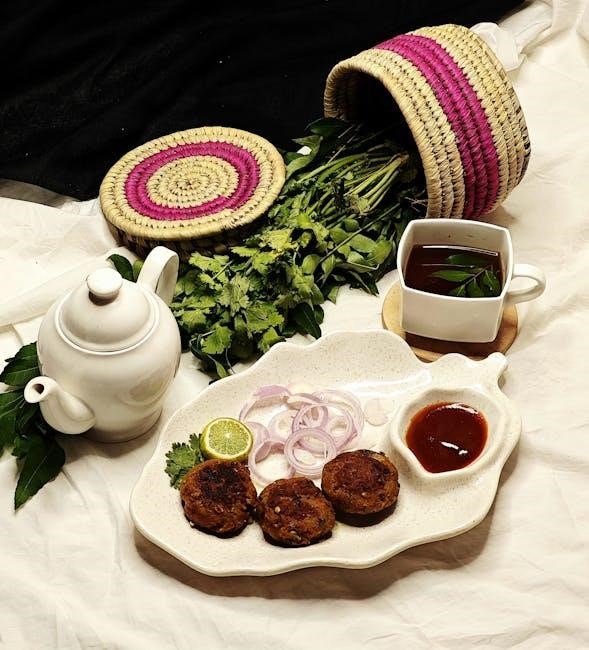
Cooking Methods
Turducken can be roasted‚ deep-fried‚ or grilled for unique flavors. Each method requires specific techniques and temperature control to ensure a perfectly cooked‚ juicy result.
Oven Roasting: Temperature and Timing
Oven roasting is a popular method for cooking turducken; Preheat your oven to 325°F to 375°F‚ depending on the size of your turducken. Place the bird breast down in a roasting pan‚ ensuring even cooking. Cover the turducken with foil for the first few hours to prevent over-browning. For a 14-16 pound turducken‚ roast for 4 hours covered and 1 hour uncovered‚ or until the internal temperature exceeds 165°F. Use a digital thermometer to check the temperature in the thickest part of the turkey‚ duck‚ and chicken. If cooking from frozen‚ add extra time and monitor closely. Always let the turducken rest for 30 minutes before carving to ensure juices redistribute evenly.
Deep-Frying: Safety and Crispiness
Deep-frying a turducken requires careful attention to safety and technique to achieve a crispy exterior and juicy interior. Use a large pot or deep fryer with at least 3-4 inches of oil‚ heated to 375°F. Pat the turducken dry to prevent splashing. Lower the bird slowly into the oil‚ ensuring it’s fully submerged. Cook for 4-5 minutes per pound‚ or until the internal temperature reaches 165°F. Avoid overcrowding the pot and never leave it unattended. Use a thermometer to monitor oil temperature. After frying‚ let the turducken rest for 10-15 minutes before carving. This method delivers a golden‚ crispy skin and a flavorful‚ tender meal.
Grilling: Achieving a Smoky Flavor
Grilling a turducken adds a smoky‚ charred flavor that enhances its richness. Preheat your grill to 375°F‚ using indirect heat to avoid burning the outer layer. Place the turducken breast-side up on the cooler side of the grill. Use wood chips like hickory or apple for added smokiness. Cook for about 4-5 hours‚ or until the internal temperature reaches 165°F. Rotate the turducken halfway through cooking to ensure even browning. Monitor the temperature closely to prevent flare-ups. Once cooked‚ let it rest for 15 minutes before carving. This method creates a crispy‚ caramelized crust while keeping the meats tender and flavorful.

Safety Guidelines
Ensure safe handling by thawing turducken in the fridge or cold water. Cook immediately after assembly to avoid bacterial growth. Always use a food thermometer to confirm internal temperatures reach 165°F for poultry and 190°F for stuffing. Prevent cross-contamination by using separate utensils and cutting boards for raw meats. Wash hands thoroughly before and after handling. Store leftovers promptly below 40°F within two hours of cooking. Follow USDA guidelines for safe food preparation to enjoy a risk-free dining experience. Proper hygiene and temperature control are crucial for a delicious and safe turducken meal. Always prioritize food safety to protect your health and the quality of your dish.
Defrosting and Thawing: Safe Practices
Defrosting and thawing are critical steps in preparing a turducken safely. Always thaw your turducken in the refrigerator‚ allowing about 24 hours for every 4-5 pounds. For faster thawing‚ submerge the wrapped turducken in cold water‚ changing the water every 30 minutes. Never thaw at room temperature‚ as this can allow bacterial growth. If using a microwave‚ follow the defrosting setting and cook immediately after thawing. Ensure the turducken is stored at 40°F or below during thawing to maintain food safety. Avoid partial thawing or refreezing‚ as this can compromise the quality and safety of the meat. Proper thawing ensures even cooking and prevents foodborne illness‚ making it essential for a safe and enjoyable meal.
Internal Temperature Requirements
Ensuring the turducken reaches a safe internal temperature is crucial for food safety and optimal flavor. The internal temperature must exceed 165°F (74°C)‚ especially in the thickest parts of the turkey‚ duck‚ and chicken. Use a digital thermometer to check the temperature in multiple areas‚ including the breast and thigh regions‚ avoiding bones or fat pockets. The chicken layer‚ being the innermost‚ often requires the most attention to ensure it reaches the safe temperature. never rely on cooking time alone‚ as this can vary based on size and stuffing. Always prioritize temperature readings to prevent undercooking or overcooking. Proper temperature control guarantees a juicy‚ evenly cooked turducken and protects against foodborne illness. This step is non-negotiable for a safe and enjoyable dining experience.
Preventing Cross-Contamination
Preventing cross-contamination is essential when handling a turducken to ensure food safety. Always use separate cutting boards and utensils for raw meats and cooked or ready-to-eat foods. Wash your hands thoroughly with soap and warm water before and after handling the turducken. Keep raw meats‚ including the turkey‚ duck‚ and chicken‚ separate from other ingredients to avoid bacterial transfer. Regularly sanitize all surfaces and tools with a food-safe cleaner. Never reuse marinades or stuffing that have come into contact with raw meat without proper cooking. Store the turducken at a safe refrigerated temperature below 40°F (4°C) until cooking. These practices minimize the risk of foodborne illness and ensure a safe dining experience for everyone. Proper hygiene habits are key to a successful and healthy meal.

Presentation and Serving
Presentation is key to impressing your guests. Carve the turducken neatly and garnish with fresh herbs or sauces. Use a decorative platter for a visually appealing display.
Carving the Turducken: Step-by-Step
Carving a turducken requires precision to showcase its layered meats. Begin by letting it rest for 20 minutes post-cooking. Use a sharp‚ long knife to slice evenly across the breast‚ ensuring each piece includes all three meats. Place the turducken on a stable surface‚ breast side up. Start by making horizontal slices from the top‚ then vertical cuts to create uniform portions. Arrange the slices on a decorative platter‚ garnishing with fresh herbs or sauces for a polished presentation. Serve immediately to maintain warmth and texture‚ offering sides like mashed potatoes or stuffing alongside. This method ensures a visually appealing and flavorful experience for your guests.
Garnishing and Plating Ideas
Garnishing and plating are crucial for a visually appealing turducken presentation. Fresh herbs like parsley‚ rosemary‚ or thyme add color and fragrance. Drizzle with au jus or gravy for moisture and shine. Arrange slices on a platter‚ fanning them slightly for an elegant display. Pair with roasted vegetables or a side of stuffing for contrast. Garnish with edible flowers or microgreens for a modern touch. Consider adding a fruit chutney or cranberry sauce for a pop of color. Ensure each plate has a balanced portion of meat‚ stuffing‚ and garnishes. Creative plating enhances the dining experience‚ making the turducken a centerpiece for special occasions. These simple touches elevate the dish to a gourmet level‚ impressing both family and guests.
Serving Sizes and Portion Control
Portion control is essential when serving turducken to ensure everyone enjoys a balanced and satisfying meal. A general rule of thumb is to estimate 1 pound of meat per person‚ including bone and stuffing. For a 12-14 pound turducken‚ plan for 6-8 servings‚ while a larger 16-18 pound bird can serve 8-10 people. Consider individual appetites and the number of sides being served. Slice the turducken evenly‚ aiming for 1-inch thick slices per portion. Use a meat thermometer to guide portioning based on doneness. Offer smaller portions for lighter eaters and larger ones for heartier appetites. This approach ensures a fair distribution and minimizes waste. Proper portioning also enhances the presentation and overall dining experience‚ making the meal more enjoyable for everyone.
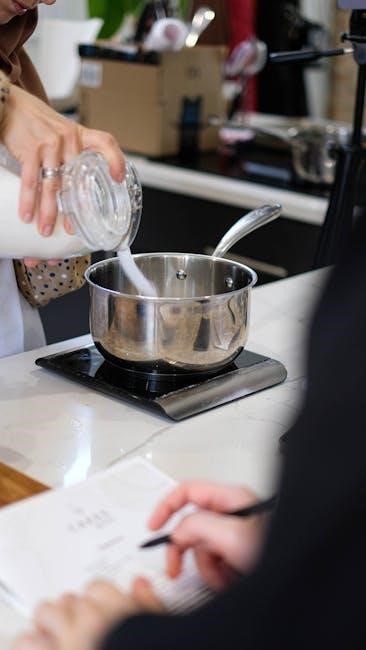
Common Mistakes to Avoid
Avoid overcooking‚ underseasoning‚ and improper thawing. Ensure internal temperatures reach 165°F and use a thermometer for accuracy. Don’t skip resting time after cooking.
Overcooking and Undercooking Issues
Overcooking can dry out the meats‚ while undercooking poses food safety risks. Ensure the internal temperature reaches 165°F using a digital thermometer. Overcooking leads to tough‚ flavorless meat‚ especially in the turkey and chicken layers. Undercooking‚ particularly in the duck‚ can leave fatty tissues under-rendered‚ affecting texture and taste. Avoid relying solely on cooking time; always verify doneness with a thermometer. Uneven heating can cause some areas to be overcooked while others remain raw; To prevent this‚ use a consistent oven temperature and rotate the turducken if necessary. Proper resting time after cooking allows juices to redistribute‚ ensuring a moist and evenly cooked dish. Adjust cooking times based on size and stuffing to avoid these common pitfalls.
Incorrect Temperature Settings
Incorrect temperature settings can significantly impact the quality and safety of your turducken. Cooking at too low a temperature may result in undercooked meat‚ while overly high heat can cause the outer layers to burn before the inner meats are fully cooked. The recommended oven temperature for roasting a turducken is between 325°F and 375°F‚ depending on the size and stuffing. Using a digital thermometer ensures accurate monitoring of internal temperatures‚ which must reach at least 165°F for food safety. Avoid guessing cooking times; precise temperature control is crucial. Additionally‚ never cook a turducken below 325°F‚ as this can lead to unsafe food conditions and uneven cooking. Always follow package instructions or trusted recipes for optimal results.
Improper Handling of the Turducken
Improper handling of the turducken can lead to a less-than-perfect dish. Avoid tearing the skin when assembling or flipping the bird‚ as this can cause uneven cooking and loss of juices. Never use sharp utensils‚ as they may puncture the meat or stuffing. When moving the turducken‚ always use sturdy‚ heat-resistant gloves or spatulas to prevent accidental drops. Overstuffing can also lead to messy cooking and uneven heating. After cooking‚ let the turducken rest before carving to ensure juices redistribute. Improper handling can compromise both flavor and presentation‚ so careful attention is essential throughout the process. Always handle the turducken gently to maintain its structural integrity and ensure a professional finish.
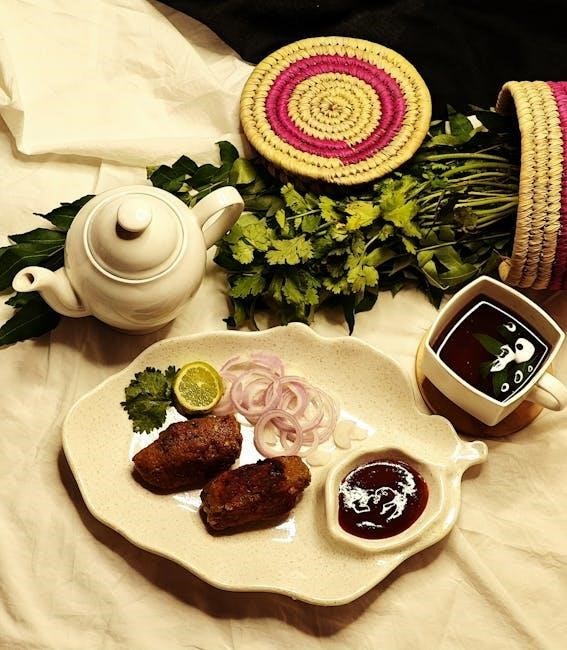
Variations and Alternatives
Turducken cooking offers creative twists‚ such as vegan versions using plant-based meats or vegetarian options with stuffed vegetables. Alternative stuffings and mini turducken cater to diverse preferences and gatherings.
Vegan and Vegetarian Options
Vegan and vegetarian turducken options offer a plant-based twist on the traditional dish. These versions replace meats with ingredients like tofu‚ tempeh‚ or seitan‚ maintaining the layered concept. Vegetarian turducken might use chicken or duck substitutes‚ while vegan versions rely entirely on plant-based proteins. Stuffing can include grains‚ vegetables‚ or legumes for added flavor and texture. Creative alternatives like stuffed portobello mushrooms or eggplant rollatini provide similar elegance. The cooking process remains similar‚ ensuring the dish is heated thoroughly for safety. These options cater to dietary preferences without compromising the festive appeal of turducken‚ making it accessible to everyone. Proper handling and cooking techniques are essential to achieve a delicious and safe meal.
Alternative Stuffings and Fillings
Exploring alternative stuffings and fillings for turducken allows for creativity and personalization. Traditional options like herb-infused bread or sausage are popular‚ but modern variations offer exciting twists. Consider using grains like quinoa or barley for a nutty flavor‚ or incorporate seafood such as shrimp or crab for a coastal twist. Vegetables like roasted mushrooms‚ spinach‚ or sweet potatoes add moisture and depth. For a spicy kick‚ jalapeño peppers or chorizo can be incorporated. Cheese-based fillings‚ such as goat cheese or cheddar‚ provide a rich‚ creamy contrast. Experiment with global flavors‚ like Korean BBQ sauce or Indian spices‚ to give your turducken a unique profile. Always ensure ingredients are cooked or toasted before stuffing to enhance flavor and texture. Balancing flavors is key to creating a memorable dish.
Mini Turducken for Smaller Gatherings
A mini turducken is a scaled-down version of the traditional dish‚ perfect for smaller gatherings or intimate meals; Typically weighing between 2 to 4 pounds‚ it still features the iconic triple-layered meats—turkey‚ duck‚ and chicken—but in a more manageable size. Cooking a mini turducken requires similar steps to its larger counterpart but with adjusted timings and temperatures. Oven roasting at 325°F for about 2-3 hours is ideal‚ ensuring the internal temperature reaches 165°F. Deep-frying is also an option‚ though it requires a smaller pot for safety. Grilling can add a smoky flavor but demands close monitoring. Thawing and seasoning processes remain the same‚ with a focus on even distribution of flavors. Mini turduckens are a great way to enjoy the dish without the need for a large crowd‚ making it a convenient yet flavorful option for any occasion.
Mastering turducken cooking involves precision in temperature‚ seasoning‚ and presentation. Ensure internal temperatures reach 165°F for safety. Experiment with flavors and enjoy the unique culinary experience.
Final Tips for a Perfect Turducken
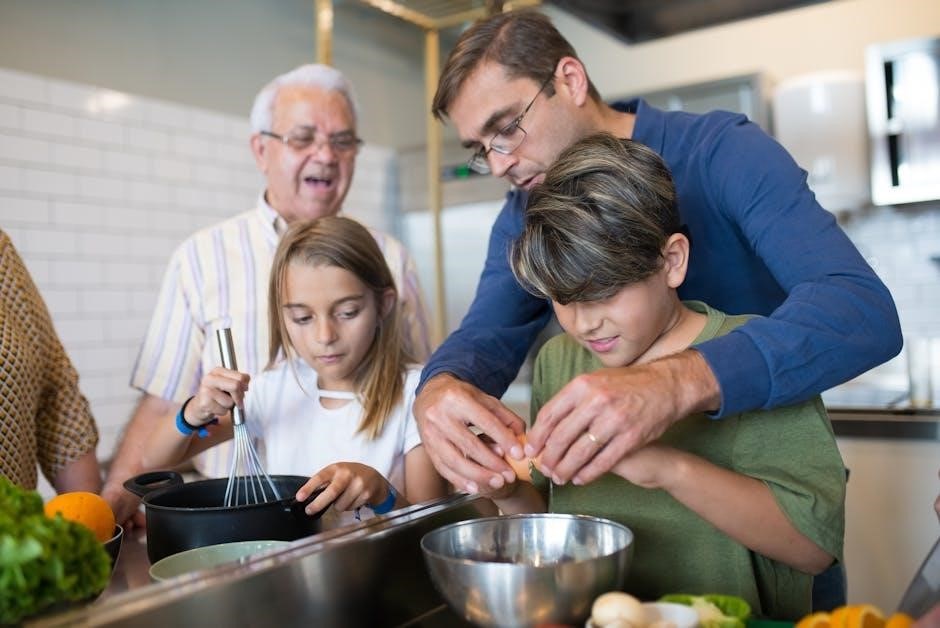
For a flawless turducken‚ ensure proper defrosting and follow safe food handling practices. Use a digital thermometer to confirm internal temperatures reach 165°F. Cook in an oven set to 375°F‚ covering for 4 hours and uncovering for the last hour to crisp the skin. Allow the turducken to rest before carving. Patience is key—slow cooking prevents overcooking. Garnish with fresh herbs for a stunning presentation. Always follow package instructions for pre-made turducken and experiment with seasonings for unique flavors. Remember‚ attention to detail ensures a memorable culinary experience.
Encouragement to Experiment and Enjoy
Embrace creativity in your turducken journey! Experiment with various stuffings like traditional herbs or modern twists such as spicy sausages. Don’t hesitate to try different marinades or rubs to enhance flavor. For smaller gatherings‚ consider mini turducken options. Remember‚ practice makes perfect‚ so don’t be discouraged by initial challenges. Share your turducken with friends and family‚ and enjoy the satisfaction of creating a unique‚ mouthwatering dish. The process is as rewarding as the result‚ so savor every step and delight in the joy of cooking a turducken.
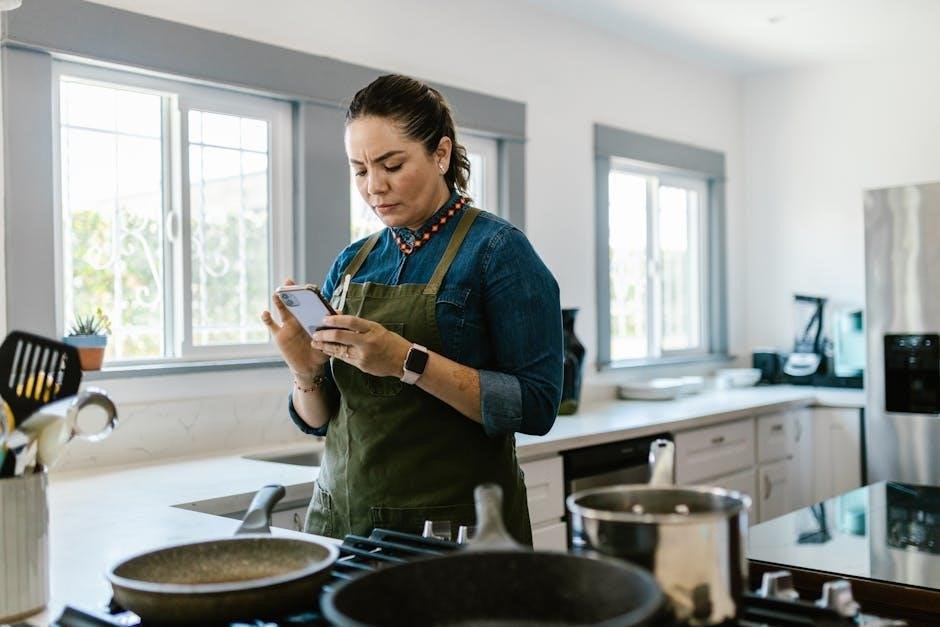
Resources for Further Learning
Expand your turducken expertise with reliable online resources. Websites like Cajun Ed’s Specialty Meats and Billy’s Meat offer detailed guides and recipes. The Food Safety and Inspection Service provides crucial safety tips‚ ensuring your dish is both delicious and safe. For visual learners‚ YouTube channels dedicated to turducken preparation can be invaluable. Additionally‚ specialty food blogs often share creative stuffing ideas and cooking techniques. Exploring these resources will enhance your confidence and skills in preparing a perfect turducken‚ making your culinary journey enjoyable and successful.
